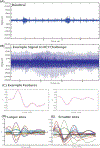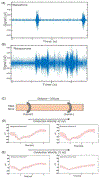A novel flexible cuff-like microelectrode for dual purpose, acute and chronic electrical interfacing with the mouse cervical vagus nerve
- PMID: 28628030
- PMCID: PMC6130808
- DOI: 10.1088/1741-2552/aa7a42
A novel flexible cuff-like microelectrode for dual purpose, acute and chronic electrical interfacing with the mouse cervical vagus nerve
Abstract
Objective: Neural reflexes regulate immune responses and homeostasis. Advances in bioelectronic medicine indicate that electrical stimulation of the vagus nerve can be used to treat inflammatory disease, yet the understanding of neural signals that regulate inflammation is incomplete. Current interfaces with the vagus nerve do not permit effective chronic stimulation or recording in mouse models, which is vital to studying the molecular and neurophysiological mechanisms that control inflammation homeostasis in health and disease. We developed an implantable, dual purpose, multi-channel, flexible 'microelectrode' array, for recording and stimulation of the mouse vagus nerve.
Approach: The array was microfabricated on an 8 µm layer of highly biocompatible parylene configured with 16 sites. The microelectrode was evaluated by studying the recording and stimulation performance. Mice were chronically implanted with devices for up to 12 weeks.
Main results: Using the microelectrode in vivo, high fidelity signals were recorded during physiological challenges (e.g potassium chloride and interleukin-1β), and electrical stimulation of the vagus nerve produced the expected significant reduction of blood levels of tumor necrosis factor (TNF) in endotoxemia. Inflammatory cell infiltration at the microelectrode 12 weeks of implantation was limited according to radial distribution analysis of inflammatory cells.
Significance: This novel device provides an important step towards a viable chronic interface for cervical vagus nerve stimulation and recording in mice.
Figures






Similar articles
-
Development and characterization of a chronic implant mouse model for vagus nerve stimulation.Elife. 2021 Apr 6;10:e61270. doi: 10.7554/eLife.61270. Elife. 2021. PMID: 33821789 Free PMC article.
-
Flexible IrOx neural electrode for mouse vagus nerve stimulation.Acta Biomater. 2023 Mar 15;159:394-409. doi: 10.1016/j.actbio.2023.01.026. Epub 2023 Jan 17. Acta Biomater. 2023. PMID: 36669547 Free PMC article.
-
A novel implantable vagus nerve stimulation system (ADNS-300) for combined stimulation and recording of the vagus nerve: pilot trial at Ghent University Hospital.Epilepsy Res. 2010 Dec;92(2-3):231-9. doi: 10.1016/j.eplepsyres.2010.10.007. Epub 2010 Nov 10. Epilepsy Res. 2010. PMID: 21071177 Clinical Trial.
-
Electrochemical and Electrophysiological Performance of Platinum Electrodes Within the Ninety-Nine-Electrode Stimulating Nerve Cuff.Artif Organs. 2015 Oct;39(10):886-96. doi: 10.1111/aor.12625. Artif Organs. 2015. PMID: 26471140 Review.
-
Vagus nerve stimulation and magnet use: optimizing benefits.Epilepsy Behav. 2009 Jul;15(3):299-302. doi: 10.1016/j.yebeh.2009.04.002. Epub 2009 May 23. Epilepsy Behav. 2009. PMID: 19361573 Review.
Cited by
-
Identification of cytokine-specific sensory neural signals by decoding murine vagus nerve activity.Proc Natl Acad Sci U S A. 2018 May 22;115(21):E4843-E4852. doi: 10.1073/pnas.1719083115. Epub 2018 May 7. Proc Natl Acad Sci U S A. 2018. PMID: 29735654 Free PMC article.
-
Direct measurement of vagal tone in rats does not show correlation to HRV.Sci Rep. 2021 Jan 13;11(1):1210. doi: 10.1038/s41598-020-79808-8. Sci Rep. 2021. PMID: 33441733 Free PMC article.
-
Recent progress on peripheral neural interface technology towards bioelectronic medicine.Bioelectron Med. 2020 Nov 30;6(1):23. doi: 10.1186/s42234-020-00059-z. Bioelectron Med. 2020. PMID: 33292861 Free PMC article. Review.
-
A Focused Review of Neural Recording and Stimulation Techniques With Immune-Modulatory Targets.Front Immunol. 2021 Sep 27;12:689344. doi: 10.3389/fimmu.2021.689344. eCollection 2021. Front Immunol. 2021. PMID: 34646261 Free PMC article. Review.
-
The development of neural stimulators: a review of preclinical safety and efficacy studies.J Neural Eng. 2018 Aug;15(4):041004. doi: 10.1088/1741-2552/aac43c. Epub 2018 May 14. J Neural Eng. 2018. PMID: 29756600 Free PMC article.
References
-
- Tracey KJ. Shock Medicine. Sci Am. 2015. February 17;312(3):28–35.
-
- Chow BY, Boyden ES. Optogenetics and translational medicine. Sci Transl Med. 2013. March 20;5(177):177ps5. - PubMed
-
- Tracey KJ. Reflexes in Immunity. Cell. 2016;164(3):343–4. - PubMed
-
- Pavlov VA, Tracey KJ. Neural regulation of immunity: molecular mechanisms and clinical translation. Nat Neurosci. 2017. 20, 156–166 - PubMed
Publication types
MeSH terms
Grants and funding
LinkOut - more resources
Full Text Sources
Other Literature Sources
